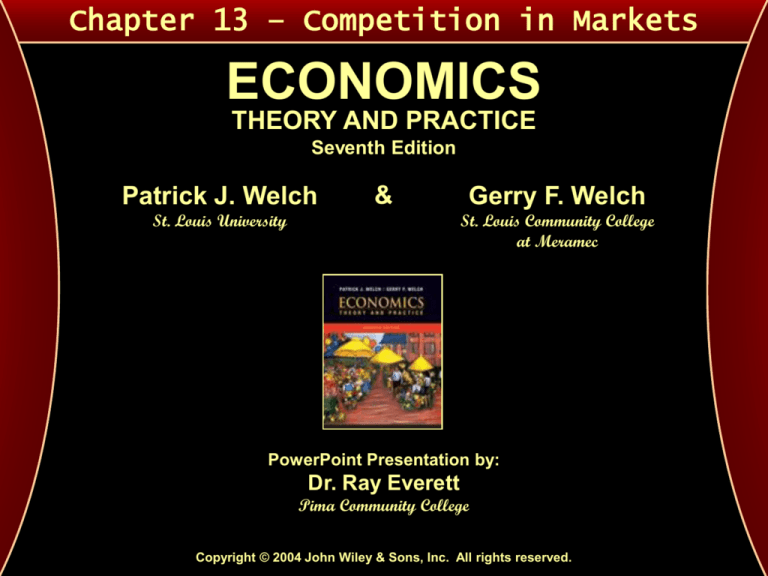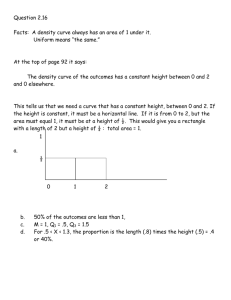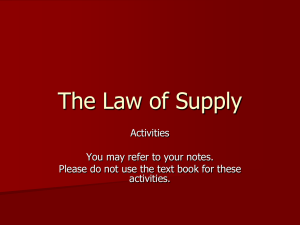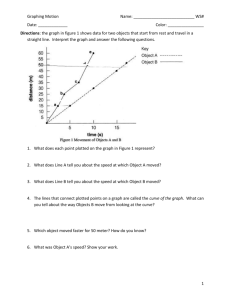
Chapter 13 – Competition in Markets
ECONOMICS
THEORY AND PRACTICE
Seventh Edition
Patrick J. Welch
&
St. Louis University
Gerry F. Welch
St. Louis Community College
at Meramec
PowerPoint Presentation by:
Dr. Ray Everett
Pima Community College
Copyright © 2004 John Wiley & Sons, Inc. All rights reserved.
Competition and Market Structures
Contents
Defining a Market
Market Structures
Pure Competition
Monopolistic Competition
Oligopoly
Monopoly
Market Structures & Efficiency
Maximizing Profit (Chapter 13 Appendix)
Competition and Market Structures
Chapter Objectives
• To define a market and explain how its boundaries are determined.
• To explain how a firm’s pricing and profit behavior are related to the
amount of competition it faces in the market.
• To give the basic characteristics of the four market structures: pure
competition, monopolistic competition, oligopoly, monopoly.
• To describe an individual firm’s demand curve, pricing behavior, and
nonprice competitive behavior in each of the four market structures.
• To explain how a firm’s long-run pricing and profit behavior and the
degree of efficiency it achieves are affected by the amount of
competition it faces in a market.
• To evaluate how consumers fare and how efficiency is achieved with
firms in each of the four market structures.
• To develop (in an appendix) the explanation of how a firm determines
its profit-maximizing price and output level.
Defining a Market
• Market Structures
System for grouping and analyzing markets according to
the degree and type of competition among sellers.
• Industry
Group of firms producing similar products or using similar
processes.
• Market
Includes firms that produce similar products or use
similar products, or use similar processes, and compete
for the same buyers.
• Geographic Boundary of a Market
Defined by the geographic area in which sellers and
buyers compete.
• Product Boundary of a Market
Defined by product substitutability among buyers.
13-1
Market Structures
• Factors Affecting a Market Model
Number of sellers
• Important to the amount of competition in a market.
Product type
• Can be identical from seller to seller or be different.
• If a firm can distinguish its product from those of its
competitors, then nonprice competition can arise.
Entry and exit
• The ease with which a firm may enter or leave a market.
13-2
Pure Competition
• Characteristics
Large number of independent sellers.
Identical products are offered for sale.
Easy entry into and exit from the market.
• Control Over Price
Price Takers
• Sellers with no control over the price of their products.
– Market demand and market supply determine the
equilibrium price and quantity of a product.
13-3a
Pure Competition
• Market Demand Curve
Demand curve for all buyers in the market together.
• Individual Firm’s Demand Curve
Amounts of an individual firm’s product that buyers are
willing to purchase at particular prices.
FIGURE 13-2
Demand Curve for the Output of a Purely Competitive Seller
13-3b
Pure Competition
• Effect of an Increase in Market Demand
Equilibrium price will increase.
Individual firm’s demand curve shifts upward.
FIGURE 13-3
Effect on the Individual Firm of an Increase in Market Demand
13-3c
Pure Competition
• Economic Profit, Loss, or Breaking Even
Occurs when price is greater than, less than, or equal to
average total cost, respectively.
• Nonprice Competition
Firms focus on a feature other than price to attract
buyers to their products.
Does not occur in purely competitive markets.
FIGURE 13-4
A Purely Competitive Seller Operating with an Economic Profit, a
Loss, or Breaking Even
13-3d
Pure Competition
• Long-Run Position
Cost of production is as low as it can possibly be.
Price of the product is as low as it can possibly be.
Consumer pays no economic profit.
FIGURE 13-5
Long-Run Position of a Purely Competitive Seller
13-3e
Pure Competition
• Effect of Entry & Exit
Entry
• Firms are attracted to a market when economic profit is
being made by individual firms in that market.
• Causes the market supply to increase and the equilibrium
price to fall.
Exit
• Firms drop out of a market in the long run when others
begin to operate at a loss.
• Causes the market supply to decrease and the equilibrium
price to rise.
13-3f
Pure Competition
• Effect of Entry & Exit (cont.)
FIGURE 13-6
Effect of Entry of Sellers into a Purely Competitive Market
FIGURE 13-7
Effect of Exit of Sellers from a Purely Competitive Market
13-3g
Pure Competition
• Purely Competitive Market Examples
13-3h
Pure Competition
• Purely Competitive Market Examples (cont.)
13-3i
Monopolistic Competition
• Characteristics
Large number of sellers, but not as many as in pure
competition.
Differentiated products.
Fairly easy entry into and exit from the market.
• Control Over Price
Due to the differentiated products, a seller may raise the
price of a product and lose only some, but not all, of its
buyers.
• Buyers do not view the product of one seller as a perfect
substitute for the product of another, and this allows the
seller to increase prices.
13-4a
Monopolistic Competition
• Individual Firm’s Demand Curve
Downward-sloping due to product differentiation.
FIGURE 13-8
Demand Curve for the Output of a Monopolistically Competitive Seller
13-4b
Monopolistic Competition
• Pricing, Profit, and Loss
Can be determined by comparing the demand curve and
average total cost curve for a product listed by a seller.
• Nonprice Competition
Due to differentiation, nonprice competition can occur
through:
• Packaging, parking, facility ambience, service, location,
quality, selection, guarantees, etc.
FIGURE 13-9
A Monopolistically Competitive Seller Operating with an Economic Profit or a Loss
13-4c
Monopolistic Competition
• Long-Run Position
Earns a normal profit.
Unlike pure competition, does not operate at minimum
average cost.
Efficiency is sacrificed for product differentiation.
FIGURE 13-10
Long-Run Position of a Monopolistically Competitive Seller
13-4d
Oligopoly
• Characteristics
Market is dominated by a few large sellers.
Products may be differentiated or identical.
Entry into the market is quite difficult.
• Control Over Price
Mutual Independence
• So few sellers exist in the market that each seller weighs
the actions and reactions of rivals in decision making.
13-5a
Oligopoly
• Individual Firm’s Product Price
Leadership Pricing
• One firm in a market sets a price that the other firms in the
market then adopt.
Kinked Demand Curve
• Assumes that rivals will not follow price decreases.
– As a seller’s price rises, the amount of its product
demanded decreases substantially, but as its price falls,
the amount demanded increases only slightly.
13-5b
Oligopoly
• Nonprice Competition
Depends on whether the products are identical or
differentiated.
• Long-Run Position
Earns an economic profit.
• Item price can be greater than its actual cost.
Inefficiency may occur due to restricted entry into the
market.
13-5c
Monopoly
• Characteristics
Only one seller.
No need to consider the issue of product differentiation.
No possibility of entry by new sellers.
• Monopolistic Examples
Public utilities
• Regulatory agencies may deny permission for new sellers
to enter the market.
Ownership of a patent
• Patent may cover a wide range of manufacturing
processes.
Sole owner of a factor necessary for production
• Cartels
Arrangement made whereby sellers formally join together
in a market to make decision as a group on matters such
as pricing.
13-6a
Monopoly
• Control Over Price
More control over its price than does a firm in any other
market.
Its demand curve is the market demand curve.
• Demand for a Monopolist’s Product
Price Searcher
• A firm that searches its downward-sloping demand curve to
find the price-output combination that maximizes its profit.
13-6b
Monopoly
• Demand for a Monopolist’s Product (cont.)
13-6c
Monopoly
• Demand for a Monopolist’s Product (cont.)
13-6d
Monopoly
• Nonprice Competition
Advertising and other nonprice competition may be
designed to make people aware of the good or service
itself, not the seller.
• Long-Run Position
Earns an economic profit.
• May be monitored or controlled by a regulatory agency.
Inefficiency may occur due to restricted entry into the
market.
13-6e
Market Structures & Efficiency
• Market Structure Overview
Pure Competition
• Buyers fare best in this market.
• In the long run, price is equal to the average total cost.
Monopolistic Competition
• In the long run, price is equal to the average total cost.
– This is not the lowest possible level due to the
downwards-sloping demand curve.
• Greater inefficiency.
Oligopoly & Monopoly
• In the long run, the price of a product can remain above its
average total cost.
• Possible inefficiency.
13-7a
Market Structures & Efficiency
• Market Structure Overview (cont.)
13-7b
Maximizing Profit (Appendix Slide 1)
• A Pure Competition Firm
TABLE 13A-1
Price, Quantity, and Revenue Information for a Purely Competitive Seller
13-8a
Maximizing Profit (Appendix Slide 2)
• A Pure Competition Firm (cont.)
Determining the Profit-Maximizing Output
• MC = MR
FIGURE 13A-1
Profit-Maximizing Output for a Purely Competitive Seller
13-8b
Maximizing Profit (Appendix Slide 3)
• A Pure Competition Firm (cont.)
Maximizing Profit or Minimizing Loss
• MC = MR
FIGURE 13A-2
A Purely Competitive Seller Maximizing Profit or Minimizing Loss
13-8c
Maximizing Profit (Appendix Slide 4)
• A Firm with a Downward-Sloping Demand Curve
Marginal revenue curve position
• Lies below the demand curve because the price must be
lowered to sell a larger quantity.
• Marginal revenue for each additional unit demanded is
therefore less than price.
FIGURE 13A-3
Demand and Marginal Revenue from Selling Chairs
13-8d
Maximizing Profit (Appendix Slide 5)
• A Firm with a Downward-Sloping Demand Curve
Determining the Profit-Maximizing Output
• DP @ (MC = MR)
• Use the demand curve price at the point where marginal
cost and marginal revenue intercept.
FIGURE 13A-4
Profit-Maximizing Output for a Firm with a Downward-Sloping Demand Curve
13-8e
Maximizing Profit (Appendix Slide 6)
• A Firm with a Downward-Sloping Demand Curve
Maximizing Profit or Minimizing Loss
• Difference between DP and ATCP @ (MC = MR)
FIGURE 13A-5
A Firm with a Downward-Sloping Demand Curve Maximizing Profit or Minimizing Loss
13-8f
Chapter 13 – Competition in Markets
This is the end of Chapter 13.
To return to the contents menu of this
chapter, click on the menu graphic to the
right of this text.
To begin Chapter 14, click on the next
chapter icon to the right of this text.
Menu
Next
Chapter
ECONOMICS
THEORY AND PRACTICE
Seventh Edition
Copyright © 2004 John Wiley & Sons, Inc. All rights reserved. Reproduction or translation of this work
beyond that permitted in Section 117 of the 1976 United States Copyright Act without the expressed
written permission of the copyright owner is unlawful. Request for further information should be
addressed to the Permissions Department, John Wiley & Sons, Inc. The purchaser may make back-up
copies for his/her own use only and not for distribution or resale. The Publisher assumes no
responsibility for errors, omissions, or damages, caused by the use of these programs or from the use
of the information contained herein.





